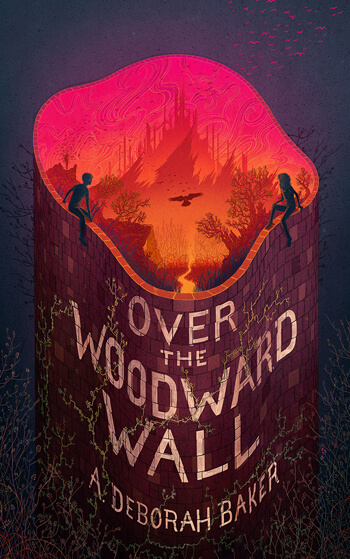It was a morning unlike any other. It was simply that no one had realized it yet.
It was supposed to be an ordinary day at school for two ordinary children who were the same age and lived on the same street and were never destined to meet. Instead the both of them climbed a brick wall that shouldn’t have been there, into a world of helpful boulders, talking owls, and a girl who is also a flock of crows. They’re soon directed to the ever changing Improbable Road and a quest to find the Impossible City so the Queen of Wands can send them back to their own world.
Zib – who will never grow into her given name of Hepzibah if she has any say in the matter – is ready for anything, with her untameable hair and her mismatched socks and her unshakeable belief that this is the marvelous thing she’s always wanted to happen to her.
Avery, on the other hand, is definitely not. Birds aren’t supposed to be able to talk, roads shouldn’t move, he’s missing school right now and he wants to go home. The very last thing he needs is an adventure.
In A. Deborah Baker’s The-Up-and-Under series, adventures are something you can’t always avoid.
“I’m sorry to be the one to tell you that, if you didn’t want an adventure, but sometimes adventures happen whether or not they’re requested. They’re like Tuesday afternoons, or headaches. Or birthdays. They do as they like.”
Let’s clarify one thing right up front. A. Deborah Baker is actually the pen name of Seanan McGuire, the author of the Hugo nominated Middlegame. Baker is also the pen name of a character in Middlegame who wrote a series of children’s books that were part of her plot to influence humankind and remake the world. The chapter headings in Middlegame often featured excerpts from this series, subtly foreshadowing the events from the main story and echoing the personalities of the two main characters. It added a lot of depth to what was already a rich and complex novel.
Realizing that there was a lot of untapped potential in the fairytale about Zib and Avery (or perhaps having planned this all along), McGuire has now started the process of actually creating the entire Up-And-Under children’s series.
You may be asking if it’s necessary to read Middlegame in order to fully understand and/or appreciate Over the Woodward Wall. The answer is: no, you don’t. Well I mean yes, you really should read Middlegame, since it’s an epic piece of fantasy/horror with transformation, and lifelong friendship, and literature and math as superpowers. But Over the Woodward Wall also works as a standalone story that I found was quirky and entertaining, and at the same time perfect for children. (Some adults may think it’s a tad scary for kids, forgetting how much children enjoy having a work of fiction that respects them enough to scare them).
For the first time, Zib realized that “adventure” was not always another way of saying “an exciting new experience” but could also be a way of saying “bad things happening very quickly, with no way to make them stop.”
The Up-and-Under is a world with its own rules, some of which follow a child’s logic, and some which are mean and cold and twist back on you when you’re not looking, which make them uncomfortably like what grown-ups think is fair (this is a theme that crops up a lot). The Improbable Road can’t be followed if you’re trying to find it, monsters will accept the shine on your shoes as payment, and animate quartz-men serve the King of Cups but they like the Queen of Wands better. In fact, all of the alliances in the Up-And-Under are tricky and prone to change, depending on who owns someone, or changed them, or took them away from their home just long enough that they have to wait a hundred years to go back.
And the setting, the glittering Improbable Road, the rivers of blue-and-pink mud, the magical creatures (who may or may not be monsters) all of these are everything I’ve loved about McGuire’s Wayward Children series. My favorite has got to be the nameless Crow Girl. The images McGuire paints of her are just fantastical, and I feel like we’re only starting to learn about the mechanics – and the cost – of being someone who can also be a few hundred other things at the same time.
The crows continued to circle, but as they circled they spiraled lower and lower, finally coming together, wings and bodies blending, black feathers flying, and somehow compressing themselves into the shape of a girl just their age.
On a surface level this is a wildly entertaining children’s story using some standard tropes (the portal to another world, the quest to find the way home, finding out that everything has a price). McGuire is also using this series to explore deeper themes, like the dangerous untruths children learn that have to be un-learned if they want to survive to adulthood, and the damage that even the most well-meaning parents can do when they try to shape their children into what they’re supposed to be, rather than seeing what they actually are.

The ending of the book feels a little abrupt, but I think that’s because the story is really just getting started. Zib and Avery are about as different from each as it’s possible to be, and it may take a while for them to realize that each of them are exactly what the other one needs. It’s going to be very interesting to see how they change throughout the series, and to see how McGuire ties this all back to MIddlegame, since it feels like that series is also just starting.
Cover illustration by David Curtis.